Spring Frost Damage to Tea Plants Can Be Identified with Daily Minimum Air Temperatures Estimated by MODIS Land Surface Temperature Products
Abstract
1. Introduction
2. Study Area and Data
2.1. Study Area
2.2. Data
2.2.1. Meteorological Data
2.2.2. MODIS Products
- (1)
- MODIS LST products
- (2)
- MODIS Land Cover Type products
2.2.3. Digital Elevation Data
2.2.4. Historical Disaster Records
3. Methodology
3.1. Reconstruction for MODIS LST
3.2. Comparison between MODIS LST and Tmin at Meteorological Stations
3.3. Estimation and Validation of Tmin
3.4. Indicators of SFD for Tea Plants
4. Results
4.1. Selection of the Best Window Scale for MODIS LST
4.2. Characteristics of Temperature from March to April
4.2.1. Annual Dynamics of Daily Tmin and LST
4.2.2. Daily Dynamics of Average Tmin and LST
4.2.3. Spatial Distribution of Extreme Tmin
4.3. Performance of the Tmin Estimation Model
4.3.1. Validation of the Tmin Estimation Model
4.3.2. Difference of Tmin between Observations and Simulations
4.3.3. Performance of the Tmin Estimation Model in Grouped Latitude and Altitude
4.4. Characteristics of SFD for Tea Plants in a Typical Frost Year
4.4.1. Temporal Characteristics of Tmin for a Typical Cooling Period
4.4.2. Spatial Distribution of Daily Minimum Air Temperature in Three Cooling Periods
4.4.3. Spatial Distribution of Different Frost Damage Levels for Tea Plants
5. Discussion and Limitations
5.1. Factors Influencing the Minimum Air Temperature Estimation Model
5.1.1. Weather Conditions
5.1.2. Land Cover Types
5.1.3. DEM
5.2. Indicators of SFD for Tea Plants
5.3. Tea Planting Area
6. Conclusions
Author Contributions
Funding
Informed Consent Statement
Data Availability Statement
Conflicts of Interest
References
- Roy, S.; Das, S.; Handique, G.; Mukhopadhysy, A.; Muraleedharan, N. Ecology and management of the black inch worm, Hyposidra talaca Walker (Geometridae: Lepidoptera) infesting Camellia sinensis (Theaceae): A review. J. Intergrative Agric. 2017, 16, 2115–2127. [Google Scholar] [CrossRef]
- Weng, K.; Xi, X.J.; Wan, X.C.; Zhao, Y.X.; Li, L.X.; Sun, W.J.; Zhang, Y.L. Classification of Tea; GB/T 30766-2014; State Administration for Market Regulation and Standardization Administration: Beijing, China, 2014. (In Chinese) [Google Scholar]
- Paiva, L.; Lima, E.; Motta, M.; Marcone, M.; Baptista, J. Variability of antioxidant properties, catechins, caffeine, L-theanine and other amino acids in different plant parts of Azorean Camellia sinensis. Curr. Res. Food Sci. 2020, 3, 227–234. [Google Scholar] [CrossRef] [PubMed]
- Jin, Z.F.; Yao, Y.P. Research on Key Technique of Meteorological Support for the Tea Production in Regions South of the Yangtze River; China Meteorological Press: Beijing, China, 2017. (In Chinese) [Google Scholar]
- FAO. FAOSTAT Database; FAO: Rome, Italy, 2020; Available online: http://www.fao.org/faostat/en/#data/QC (accessed on 19 August 2020).
- Sun, X.B.; Tao, S.H.; Tian, Q.; Cao, S.X.; Liu, R.N.; Wang, Z.Q.; Chen, X.X. Forecast of first plucking date of spring tea and evaluation of tea climate quality grade in Jingxian, Anhui. Chin. Agric. Sci. Bull. 2017, 33, 49–54, (In Chinese with English abstract). [Google Scholar]
- Wang, J.Z.; Huang, J.C.; Wang, S.; Chen, Y.Y.; An, X.J.; Zhang, L.J. Effects of light and temperature factors on quality tea of Meitancuiya in Spring. Guizhou Agric. Sci. 2019, 47, 108–112, (In Chinese with English abstract). [Google Scholar]
- Jin, J.; Diao, X.G.; Feng, H.Q. The status and development trend forecast of Zhejiang tea industry in 2019. China Tea. 2020, 3, 53–57. [Google Scholar]
- IPCC. Summary for policymakers. In Climate Change 2013: The Physical Science Basis. Contribution of Working Group I to the Fifth Assessment Report of the Intergovernmental Panel on Climate Change; Stocker, T.F., Qin, D., Plattner, G.-K., Tignor, M., Allen, S.K., Boschung, J., Nauels, A., Xia, Y., Bex, V., Midgley, P.M., Eds.; Cambridge University Press: Cambridge, UK; New York, NY, USA, 2013; p. 1535. [Google Scholar]
- Kodra, E.; Steinhaeuser, K.; Ganguly, A.R. Persisting cold extremes under 21st-century warming scenarios. Geophys. Res. Lett. 2011, 38, 99–106. [Google Scholar] [CrossRef]
- Augspurger, C.K. Reconstructing patterns of temperature, phenology, and frost damage over 124 years: Spring damage risk is increasing. Ecology 2013, 94, 41–50. [Google Scholar] [CrossRef] [PubMed]
- Rigby, J.R.; Porporato, A. Spring frost risk in a changing climate. Geophys. Res. Lett. 2008, 35, L12703. [Google Scholar] [CrossRef]
- Snyder, R.L. Principles of Frost Protection. 2000. Available online: http://biomet.ucdavis.edu/frostprotection/Principles%20of%20Frost%20Protection/FP005.html (accessed on 24 August 2020).
- Barlow, K.M.; Christy, B.P.; O’Leary, G.J.; Riffkin, P.A.; Nuttall, J.G. Simulating the impact of extreme heat and frost events on wheat crop production: A review. Field Crop. Res. 2015, 171, 109–119. [Google Scholar] [CrossRef]
- Zhao, L.C.; Li, Q.Z.; Zhang, Y.; Wang, H.Y.; Du, X. Normalized NDVI valley area index (NNVAI)-based framework for quantitative and timely monitoring of winter wheat frost damage on the Huang-Huai-Hai Plain, China. Agric. Ecosyst. Environ. 2020, 292, 106793. [Google Scholar] [CrossRef]
- Reinsdorf, E.; Koch, H.J. Modeling crown temperature of winter sugar beet and its application in risk assessment for frost killing in Central Europe. Agric. For. Meteorol. 2013, 182–183, 21–30. [Google Scholar] [CrossRef]
- Pulatov, B.; Linderson, M.; Hall, K.; Jönsson, A.M. Modeling climate change impact on potato crop phenology, and risk of frost damage and heat stress in northern Europe. Agric. For. Meteorol. 2015, 214–215, 281–292. [Google Scholar] [CrossRef]
- Vitasse, Y.; Schneider, L.; Rixen, C.; Christen, D.; Rebetez, M. Increase in the risk of exposure of forest and fruit trees to spring frosts at higher elevations in Switzerland over the last four decades. Agric. For. Meteorol. 2018, 248, 60–69. [Google Scholar] [CrossRef]
- Kotikot, S.M.; Flores, A.; Griffin, R.E.; Sedah, A.; Nyaga, J.; Mugo, R.; Limaye, A.; Irwin, D.E. Mapping threats to agriculture in East Africa: Performance of MODIS derived LST for frost identification in Kenya’s tea plantations. Int. J. Appl. Earth Obs. Geoinf. 2018, 72, 131–139. [Google Scholar] [CrossRef]
- Awaya, Y.; Tanaka, K.; Kodani, E.; Nishizono, T. Responses of a beech (Fagus crenata Blume) stand to late spring frost damage in Morioka, Japan. For. Ecol. Manag. 2009, 257, 2359–2369. [Google Scholar] [CrossRef]
- Bascietto, M.; Bajocco, S.; Mazzenga, F.; Matteucci, G. Assessing spring frost effects on beech forests in Central Apennines from remotely-sensed data. Agric. For. Meteorol. 2018, 248, 240–250. [Google Scholar] [CrossRef]
- Allevato, E.; Saulino, L.; Cesarano, G.; Chirico, G.B.; D’Urso, G.; Bolognesi, S.F.; Rita, A.; Rossi, S.; Saracino, A.; Bonanomi, G. Canopy damage by spring frost in European beech along the Apennines: Effect of latitude, altitude and aspect. Remote Sens. Environ. 2019, 225, 431–440. [Google Scholar] [CrossRef]
- Jin, Z.F.; Ye, J.G.; Yang, Z.Q.; Sun, R.; Hu, B.; Li, R.Z. Climate suitability for tea growing in Zhejiang Province. Chin. J. Appl. Ecol. 2014, 25, 967–973, (In Chinese with English abstract). [Google Scholar] [CrossRef]
- Wu, Y.; Jin, Z.F.; Ye, J.G.; Yang, Z.Q.; Hu, B.; Li, R.Z. Teleconnection analysis between spring frost damage on tea in Zhejiang Province and sea surface temperature in Pacific. Chin. J. Agrometeorol. 2014, 35, 434–439, (In Chinese with English abstract). [Google Scholar] [CrossRef]
- Li, R.Z.; Jin, Z.F.; Yang, Z.Q.; Wang, Z.H.; Yao, Y.P. Revision on meteorological indices of spring frost disaster for Camellia Sinensis in Zhejiang Province. Chin. J. Ecol. 2016, 35, 2659–2666, (In Chinese with English abstract). [Google Scholar]
- Jin, Z.F.; Yao, Y.P.; Gao, L.; Wang, Z.H.; Yu, L.Y.; Chen, H.; Li, R.Z. Grade of Frost Damage to Tea Plant; QX/T 410—2017; China Meteorological Administration: Beijing, China, 2017. (In Chinese) [Google Scholar]
- Hu, B.; Jin, Z.F.; Yan, J.Z.; Li, R.Z. Temporal and spatial distribution of early spring frost of Camellia Sinensic in Zhejiang Province based on FastICA. Chin. Agric. Sci. Bull. 2014, 30, 190–196, (In Chinese with English abstract). [Google Scholar]
- Lou, W.P.; Wu, L.H.; Ji, Z.W. The contribution of climate change to economic output of Wuniuzao spring tea in Shaoxing. Chin. J. Ecol. 2014, 33, 3358–3367, (In Chinese with English abstract). [Google Scholar] [CrossRef]
- Jin, Z.F.; Hu, B.; Yan, J.Z.; Yang, Z.Q.; Li, R.Z.; Ye, J.G. Agro-meteorological disaster risk evaluation of tea planting in Zhejiang Province. Chin. J. Ecol. 2014, 33, 771–777, (In Chinese with English abstract). [Google Scholar] [CrossRef]
- Zhu, W.B.; Lv, A.F.; Jia, S.F. Estimation of daily maximum and minimum air temperature using MODIS land surface temperature products. Remote Sens. Environ. 2013, 130, 62–73. [Google Scholar] [CrossRef]
- Vancutsem, C.; Ceccato, P.; Dunku, T.; Connor, S.J. Evaluation of MODIS land surface temperature data to estimate air temperature in different ecosystems over Africa. Remote Sens. Environ 2010, 114, 449–465. [Google Scholar] [CrossRef]
- Pouteau, R.; Rambal, S.; Ratte, J.P.; Gogé, F.; Joffre, R.; Winkel, T. Downscaling MODIS-derived maps using GIS and boosted regression trees: The case of frost occurrence over the Arid Andean Highlands of Bolivia. Remote Sens. Environ. 2011, 115, 117–129. [Google Scholar] [CrossRef]
- Lin, S.P.; Moore, N.J.; Messina, J.P.; Devisser, M.H.; Wu, J.P. Evaluation of estimating daily maximum and minimum air temperature with MODIS data in east Africa. Int. J. Appl. Earth Obs. Geoinf. 2012, 18, 128–140. [Google Scholar] [CrossRef]
- Zeng, L.L.; Wardlow, B.D.; Tadesse, T.; Shan, J.; Hayes, M.J.; Li, D.R.; Xiang, D.X. Estimation of Daily Air Temperature Based on MODIS Land Surface Temperature Products over the Corn Belt in the US. Remote Sens. 2015, 7, 951–970. [Google Scholar] [CrossRef]
- Fu, G.; Shen, Z.X.; Zhang, X.Z.; Shi, P.L.; Zhang, Y.J.; Wu, J.S. Estimating air temperature of an alpine meadow on the Northern Tibetan Plateau using MODIS land surface temperature. Acta Ecol. Sin. 2011, 31, 8–13. [Google Scholar] [CrossRef]
- Wang, P.J.; Gao, F.; Masek, J.G. Operational data fusion framework for building frequent Landsat-like imagery. IEEE Trans. Geosci. Remote Sens. 2014, 52, 7353–7365. [Google Scholar] [CrossRef]
- Rao, Y.H.; Liang, S.L.; Wang, S.D.; Yu, Y.Y.; Song, Z.; Zhou, Y.; Shen, M.G.; Xu, B.Q. Estimating daily average surface air temperature using satellite land surface temperature and top-of-atmosphere radiation products over the Tibetan Plateau. Remote Sens. Environ. 2019, 234, 111462. [Google Scholar] [CrossRef]
- Xu, Y.M.; Shen, Y. Reconstruction of the land surface temperature time series using harmonic analysis. Comput. Geosci. 2013, 61, 126–132. [Google Scholar] [CrossRef]
- Sun, L.; Chen, Z.X.; Gao, F.; Anderson, M.; Song, L.S.; Wang, L.M.; Hu, B.; Yang, Y. Reconstructing daily clear-sky land surface temperature for cloudy regions from MODIS data. Comput. Geosci. 2017, 105, 10–20. [Google Scholar] [CrossRef]
- Zhang, Y.F.; Chen, Y.H.; Li, Y.; Xia, H.P.; Li, J. Reconstructing One Kilometre Resolution Daily Clear-Sky LST for China’s Landmass Using the BME Method. Remote Sens. 2019, 11, 2610. [Google Scholar] [CrossRef]
- Zhao, W.; Duan, S.B. Reconstruction of daytime land surface temperatures under cloud-covered conditions using integrated MODIS/Terra land products and MSG geostationary satellite data. Remote Sens. Environ. 2020, 247, 111931. [Google Scholar] [CrossRef]
- Ding, Y.M.; Wang, W.G.; Song, R.M.; Shao, Q.X.; Jiao, X.Y.; Xing, W.Q. Modeling spatial and temporal variability of the impact of climate change on rice irrigation water requirements in the middle of lower reaches of the Yangtze River, China. Agric. Water Manag. 2017, 193, 89–101. [Google Scholar] [CrossRef]
- Wan, Z.M.; Zhang, Y.L.; Zhang, Q.C.; Li, Z.L. Validation of the land-surface temperature products retrieved from Terra Moderate Resolution Imaging Spectroradiometer data. Remote Sens. Environ. 2002, 83, 163–180. [Google Scholar] [CrossRef]
- Sulla-Menashe, D.; Friedl, M.A. User guide to collection 6 MODIS Land Cover (MCD12Q1 and MCD12Q2) Product. 2018. Available online: https://lpdaac.usgs.gov/documents/101/MCD12_User_Guide_V6.pdf (accessed on 7 January 2021).
- Abrams, M.; Crippen, R. User Guide of ASTER GDEM V3. 2019. Available online: https://catalog.data.gov/dataset/aster-global-digital-elevation-model-v003 (accessed on 17 March 2021).
- Dong, W.J. Yearbooks of Meteorological Disasters in China; China Meteorological Press: Beijing, China, 2007. [Google Scholar]
- Jamieson, P.D.; Porter, J.R.; Wilson, D.R. A test of the computer simulation model ARCWheat1 on wheat crops grown in New Zealand. Field Crop. Res. 1991, 27, 337–350. [Google Scholar] [CrossRef]
- Nash, J.E.; Sutcliffe, J.V. River flow forecasting through conceptual models part I—A discussion of principles. J. Hydrol. 1970, 10, 282–290. [Google Scholar] [CrossRef]
- Wang, E.L.; Martre, P.; Zhao, Z.G.; Ewert, F.; Maiorano, A.; Rötter, R.P.; Kimball, B.A.; Ottman, M.J.; Wall, G.W.; White, J.W.; et al. The uncertainty of crop yield projections is reduced by improved temperature response functions. Nat. Plants 2017, 3, 17102. [Google Scholar] [CrossRef]
- Yang, J.Y.; Huo, Z.G.; Wu, L.; Wang, T.Y.; Zhang, G.X. Indicator-based evaluation of spatiotemporal characteristics of rice flood in Southwest China. Agric. Ecosyst. Environ. 2016, 230, 221–230. [Google Scholar] [CrossRef]
- Wang, P.J.; Zhou, Y.Y.; Huo, Z.G.; Han, L.J.; Qiu, J.X.; Tan, Y.J.; Liu, D. Monitoring growth condition of spring maize in Northeast China using a process-based model. Int. J. Appl. Earth Obs. Geoinf. 2018, 66, 27–36. [Google Scholar] [CrossRef]
- Tang, Y.X.; Guo, J.P. Risk Assessment of Maize Chilling Injury in Northeast China. J. Appl. Meteorol. Sci. 2016, 27, 352–360, (In Chinese with English abstract). [Google Scholar] [CrossRef]
- Liu, L.L.; Ji, H.T.; An, J.P.; Shi, K.J.; Ma, J.F.; Liu, B.; Tang, L.; Cao, W.X.; Zhu, Y. Response of biomass accumulation in wheat to low-temperature stress at jointing and booting stages. Environ. Exp. Bot. 2019, 157, 46–57. [Google Scholar] [CrossRef]
- Wang, X.L. Risk Evaluation Technology Research of Spring frost Injury in Southern Yangtze Tea Areas. Master’s Thesis, Nanjing University of Information Science & Technology, Nanjing, China, 2015. (In Chinese with English abstract). [Google Scholar]
- Jiang, Y.M.; Jin, Z.F.; Li, R.Z.; Zhang, Y.H.; Yu, W.J. Temporal and spatial distribution of early spring frost for spring tea in southern Zhejiang. Meteorol. Sci. Technol. 2016, 44, 1066–1077, (In Chinese with English abstract). [Google Scholar]
- Xu, J.Q.; Qiu, X.F.; Zeng, Y.; Shi, G.P.; Wei, X.H. Analysis on the characteristics of climate change of spring frost damage on tea in Zhejiang. Jiangsu Agric. Sci. 2018, 46, 101–105, (In Chinese with English abstract). [Google Scholar]
- Meng, Z.; Yang, D.; Jin, Z.F.; Wang, Z.H.; Lu, D.B. Effect of low temperature and frost on April 1 on tea product in Zhejiang. J. Zhejiang Agric. Sci. 2019, 60, 1397–1400, (In Chinese with English abstract). [Google Scholar]
- Wolfe, R.E.; Nishihama, M. Trends in MODIS geolocation error analysis. In Proceedings of the Earth Observing Systems XIV, San Diego, CA, USA, 2–6 August 2009. [Google Scholar]
- Duan, S.B.; Li, Z.L.; Tang, B.H.; Wu, H.; Tang, R.L. Direct estimation of land-surface diurnal temperature cycle model parameters from MSG-SEVIRI brightness temperatures under clear sky conditions. Remote Sens. Environ. 2014, 150, 34–43. [Google Scholar] [CrossRef]
- Wang, J.; Kuai, Z.M.; Zhang, X.H. The impact of spatial and temporal evolution in climatology of spring frost on spring tea in Jiangsu Province. Chin. J. Agrometeorol. 2011, 32 (Suppl. 1), 222–226, (In Chinese with English abstract). [Google Scholar]
- Liu, R.N.; Chen, P. Occurrence regularity of tea spring frost and its risk distribution in Anhui Province. Meteorol. Sci. Technol. 2016, 44, 1060–1065, (In Chinese with English abstract). [Google Scholar]
- Cheruy, F.; Dufresne, J.L.; Mesbah, S.A.; Grandpeix, J.Y.; Wang, F. Role of soil thermal inertia in surface temperature and soil moisture-temperature feedback. J. Adv. Modeling Earth Syst. 2017, 9, 2906–2919. [Google Scholar] [CrossRef]
- Wan, Z.M. New refinements and validation of the collection-6 MODIS land-surface temperature/emissivity product. Remote Sens. Environ. 2014, 140, 36–45. [Google Scholar] [CrossRef]
- Hu, L.Q.; Sun, Y.; Collins, G.; Fu, P. Improved estimates of monthly land surface temperature from MODIS using a diurnal temperature cycle (DTC) model. ISPRS J. Photogramm. Remote Sens. 2020, 168, 131–140. [Google Scholar] [CrossRef]
- Liu, X.Y.; Tang, B.H.; Li, Z.L.; Zhou, C.H.; Wu, W.B.; Rasmussen, M.O. An improved method for separating soil and vegetation component temperatures based on diurnal temperature cycle model and spatial correlation. Remote Sens. Environ. 2020, 248, 111979. [Google Scholar] [CrossRef]
- Sun, D.; Pinker, R.T.; Kafatos, M. Diurnal temperature range over the United States: A satellite view. Geophys. Res. Lett. 2006, 33, L05705. [Google Scholar] [CrossRef]
- Wang, P.J.; Tang, J.X.; Jin, Z.F.; Ma, Y.P.; Chen, H. Review on Spring Frost Disaster for Tea Plant in China. J. Appl. Meteorol. Sci. 2021, 32, 129–145, (In Chinese with English abstract). [Google Scholar] [CrossRef]
- Yu, L.P.; Wang, C.; Wang, Z.H. Quantitative evaluation model of frost disaster in early spring tea in Zhejiang Province. Meteorol. Environ. Sci. 2017, 40, 70–74, (In Chinese with English abstract). [Google Scholar]
- Tao, Y.; Yang, A.P.; Duan, L.C.; Zhang, K. Quantitative evaluation of the effect of spring frost disaster on tea production in northern Jiangxi in 2018. Meteorol. Disaster Reduct. Res. 2019, 42, 70–74, (In Chinese with English abstract). [Google Scholar]
- National Bureau of Statistics. China Statistical Yearbook 2020; China Statistics Press: Beijing China, 2020.
- Shen, T.Q.; Qiu, X.F.; Wei, X.H.; Zhu, X.C.; Xu, J.Q. Risk assessment of tea spring frost disaster in detailed plantation area of tea tree—Taking Songyang County of Zhejiang Province as an example. Jiangsu Agric. Sci. 2019, 47, 262–268. (In Chinese) [Google Scholar]
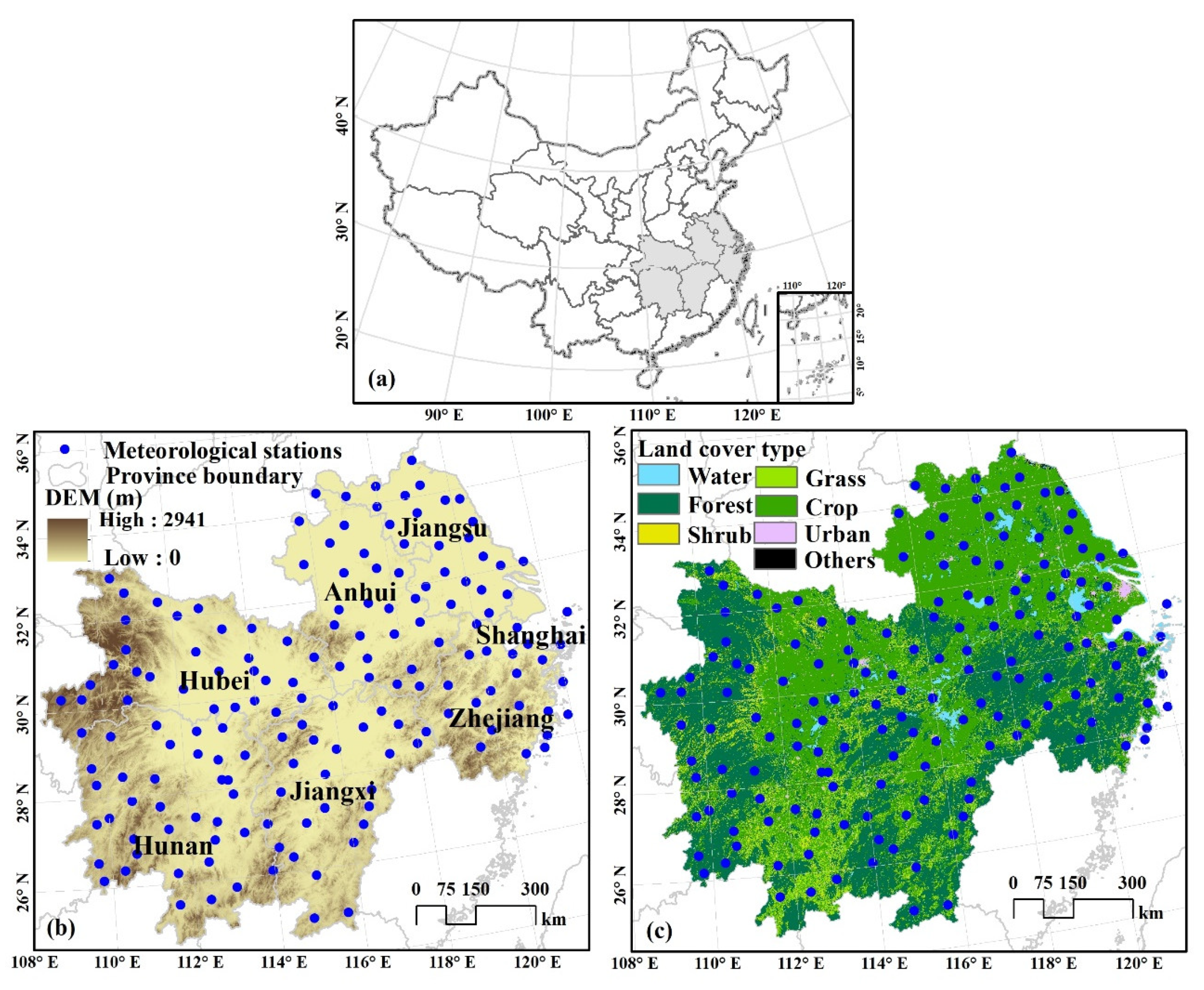
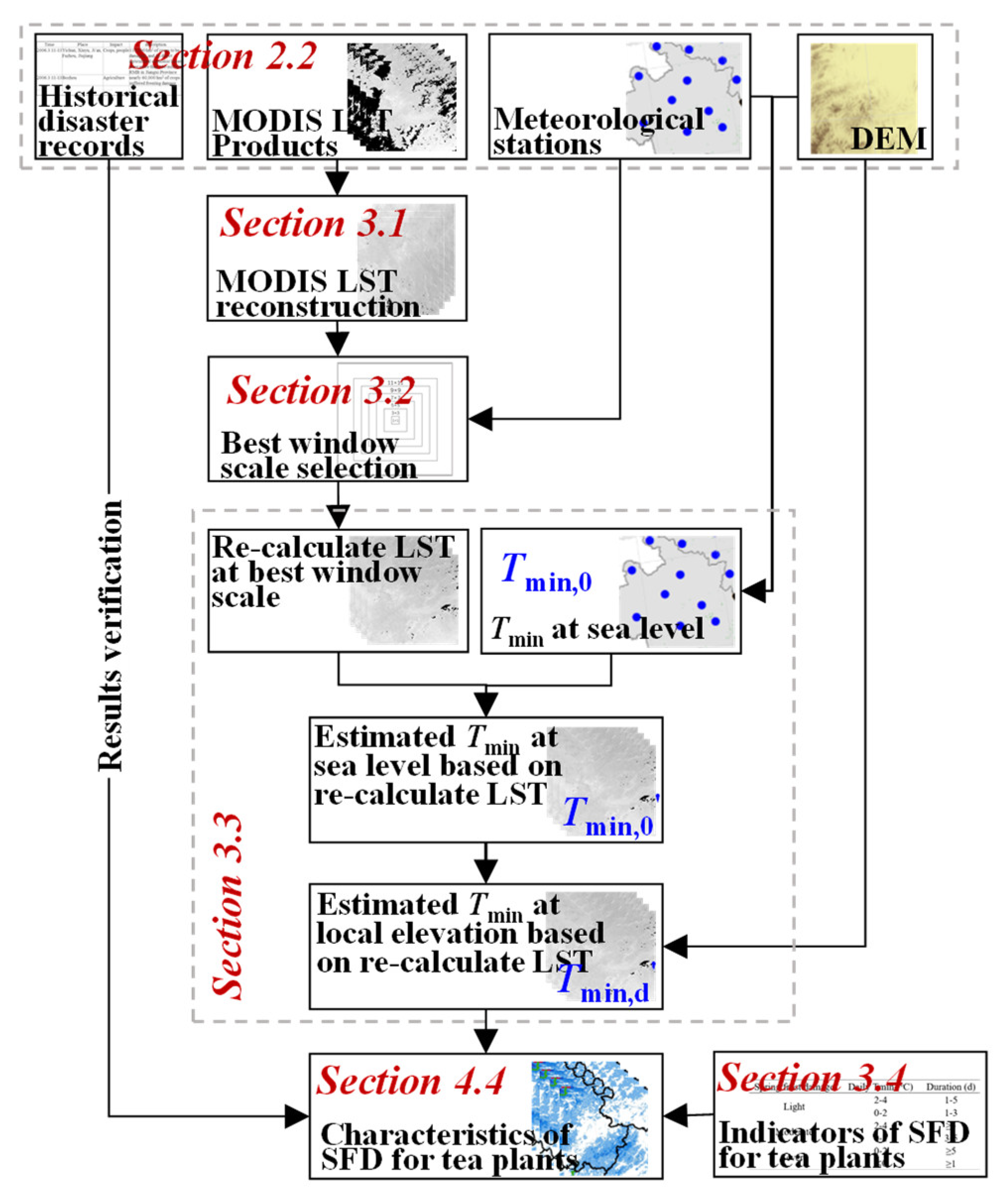



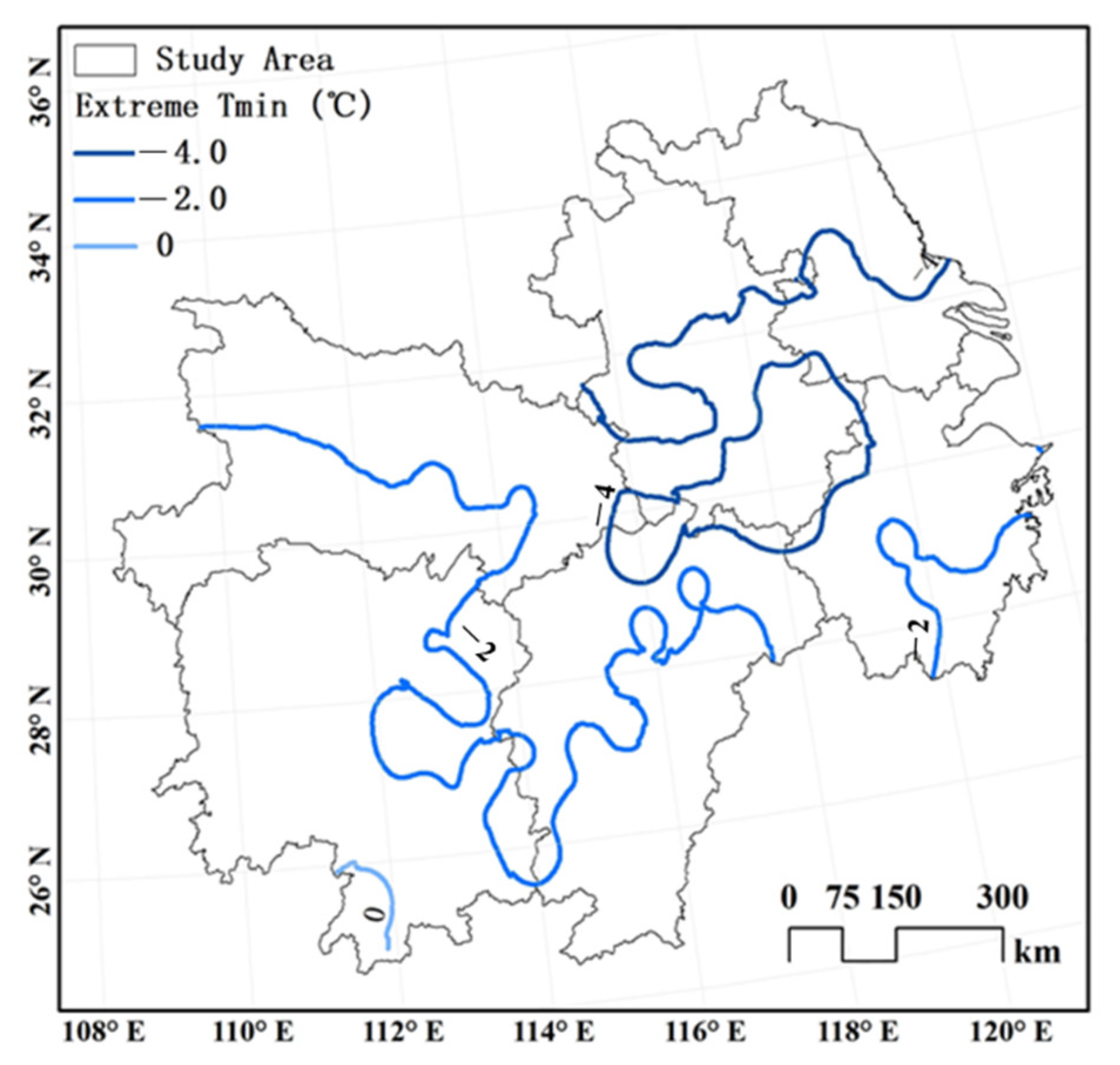
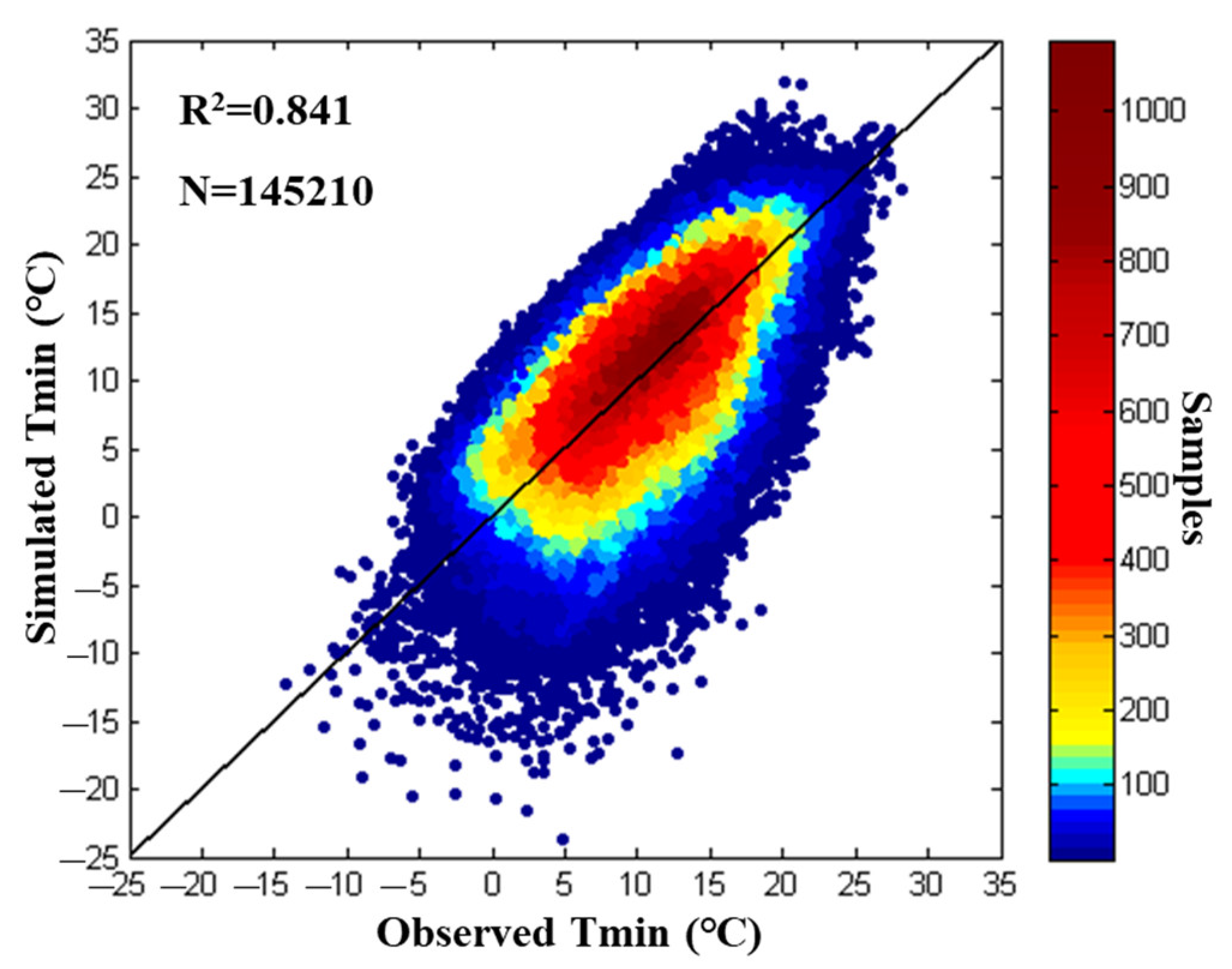
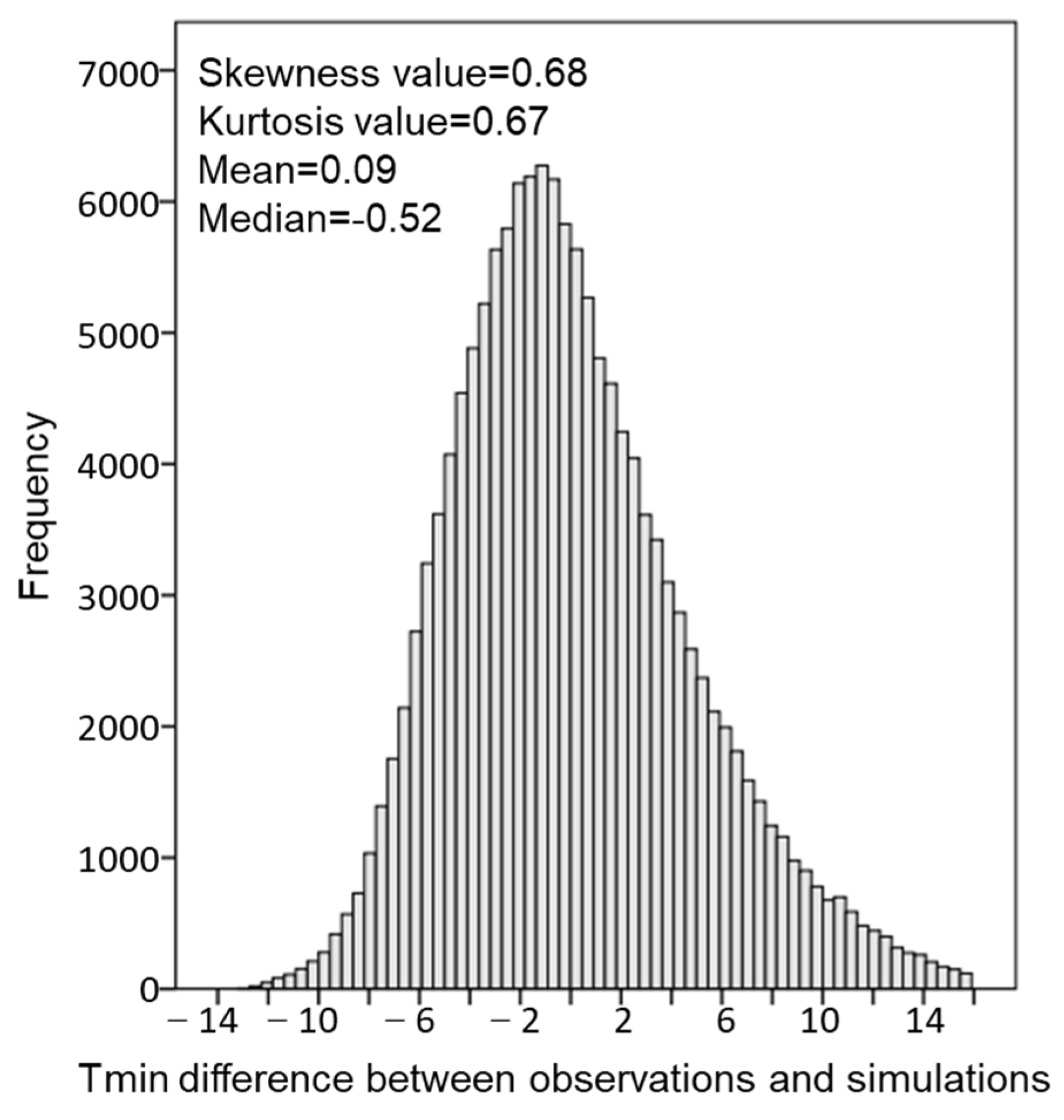
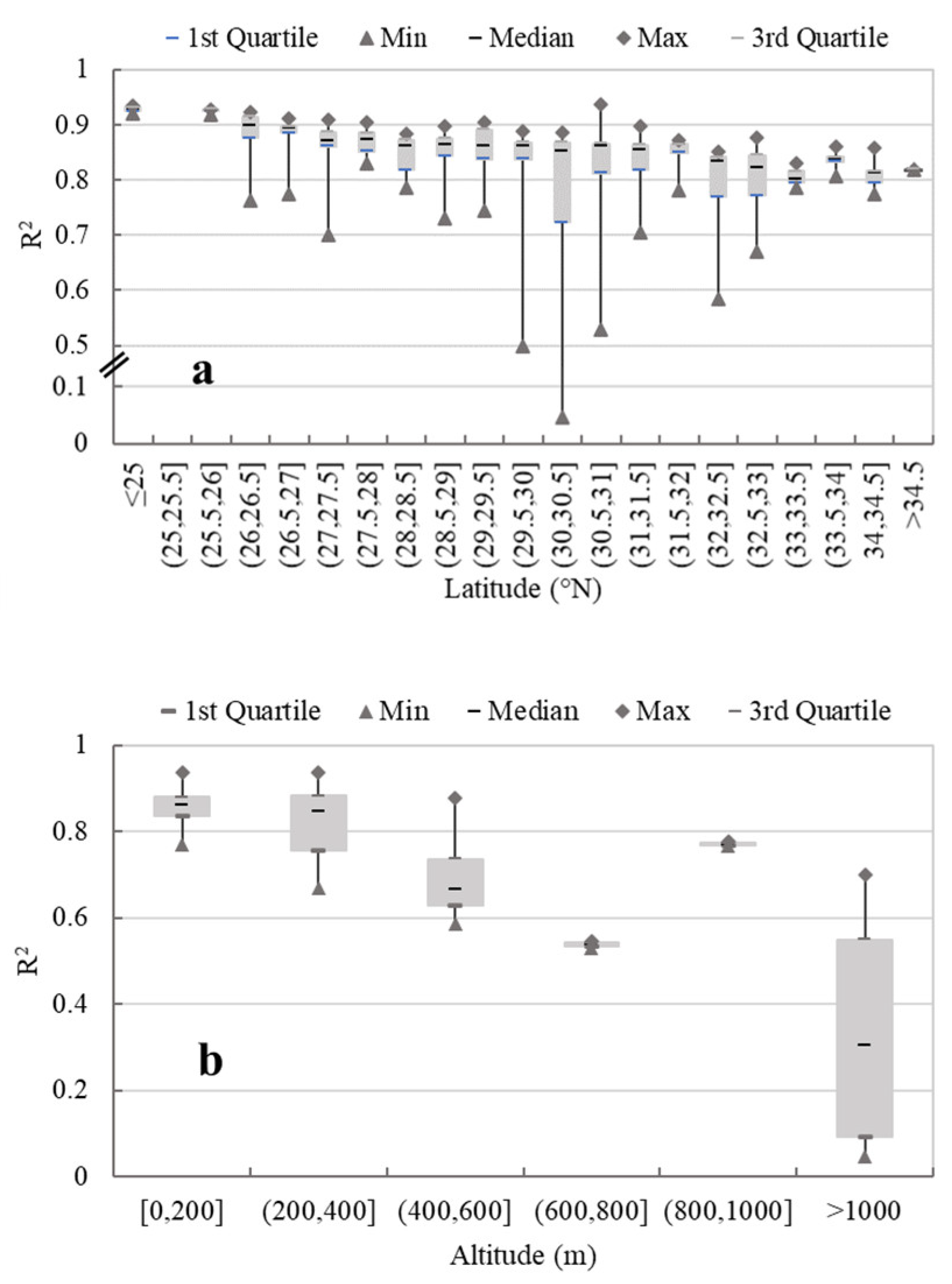

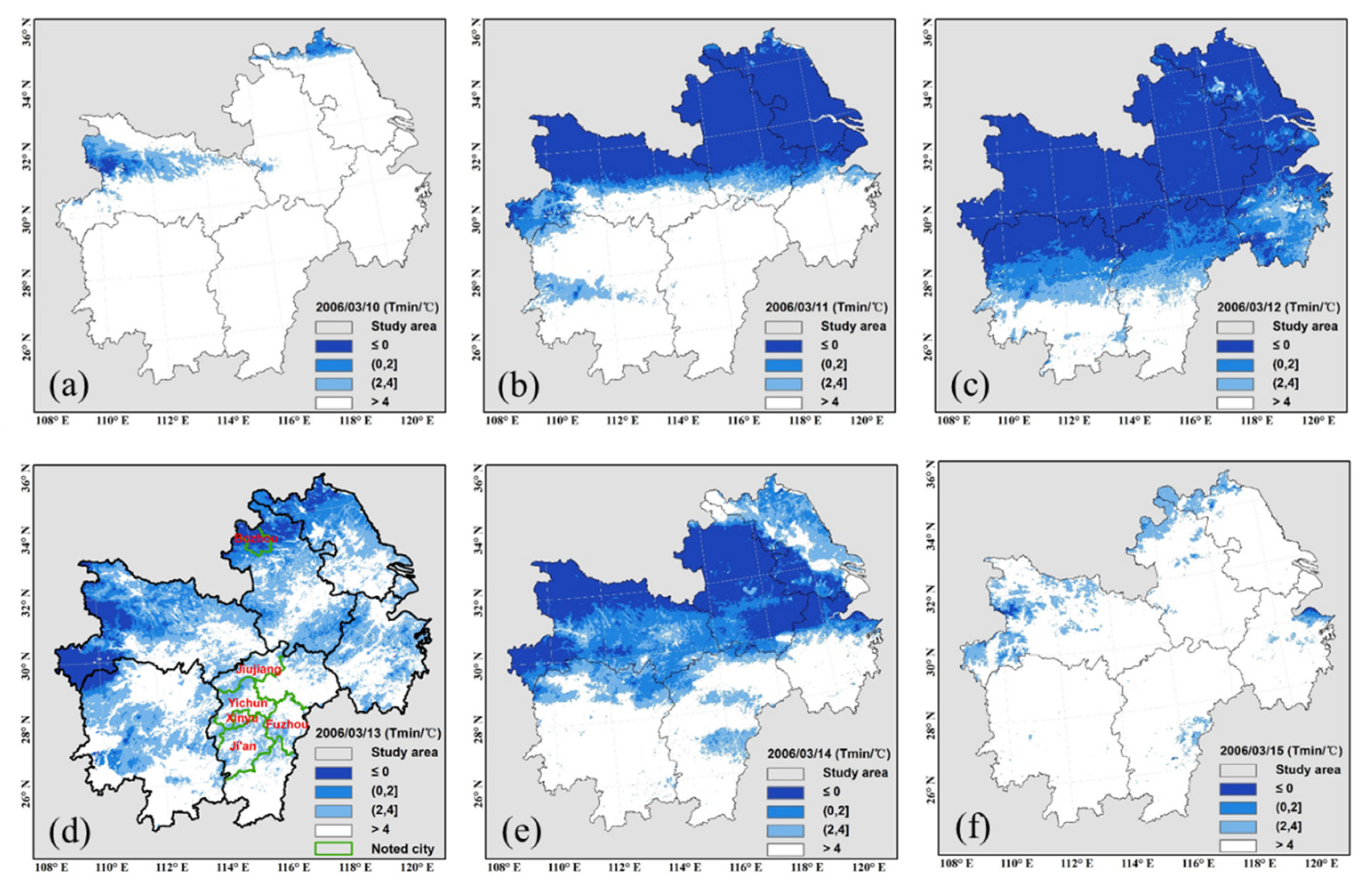
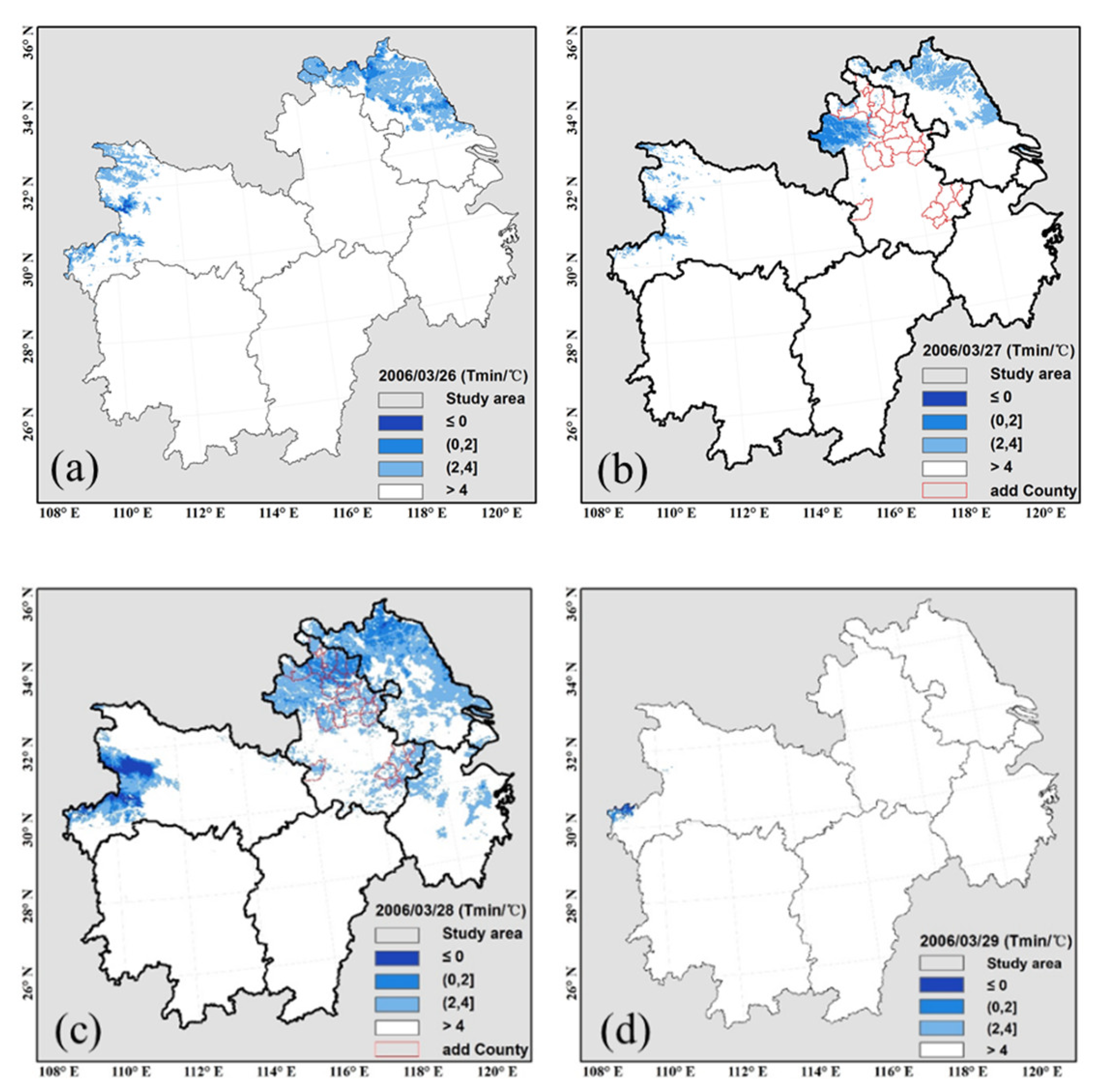
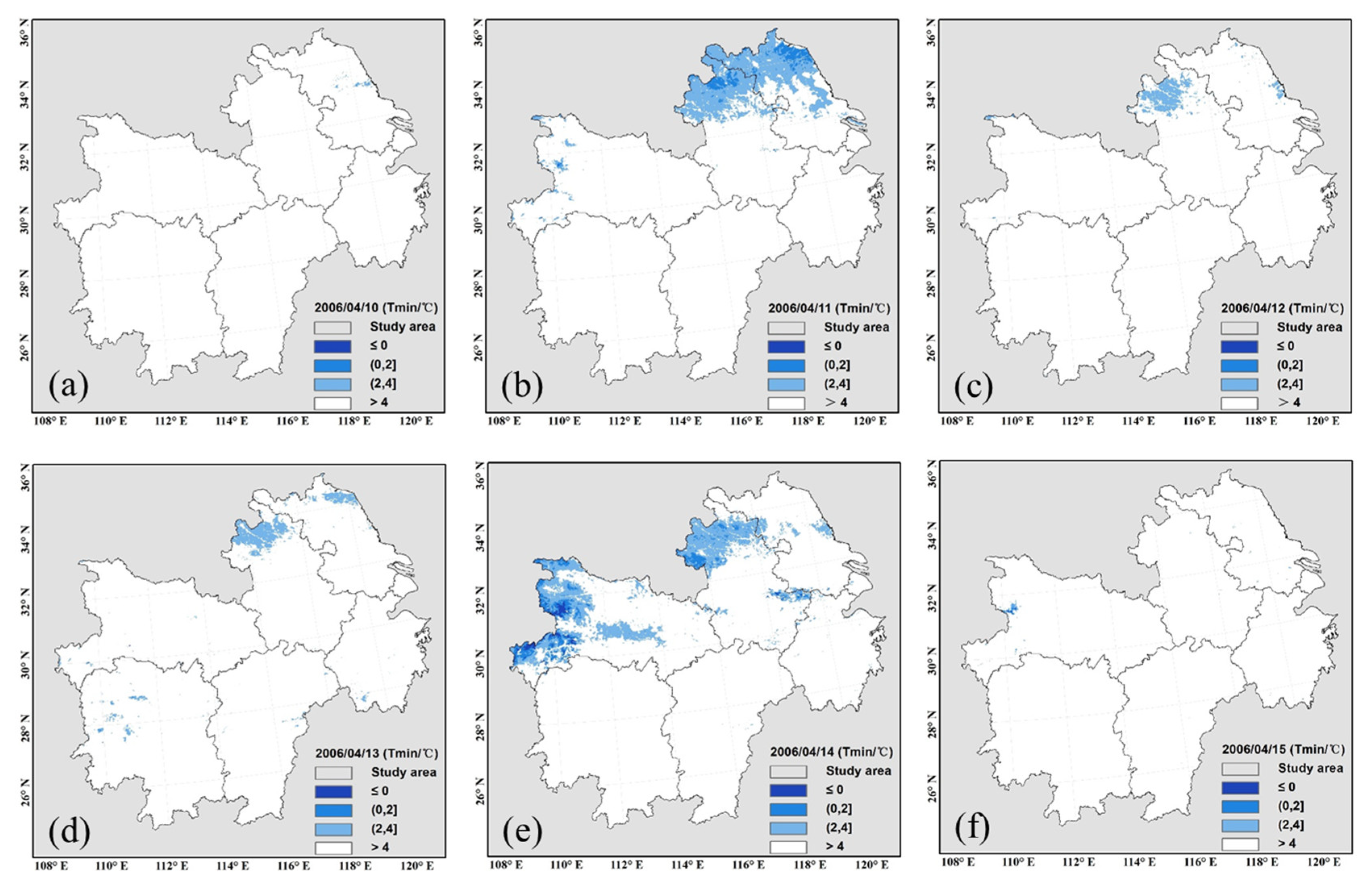

| Spring Frost Damage | Daily Tmin (°C) | Duration (d) |
|---|---|---|
| Light | 2–4 | 1–5 |
| 0–2 | 1–3 | |
| Moderate | 2–4 | ≥5 |
| 0–2 | 3–5 | |
| Severe | 0–2 | ≥5 |
| 0 | ≥1 |
Publisher’s Note: MDPI stays neutral with regard to jurisdictional claims in published maps and institutional affiliations. |
© 2021 by the authors. Licensee MDPI, Basel, Switzerland. This article is an open access article distributed under the terms and conditions of the Creative Commons Attribution (CC BY) license (http://creativecommons.org/licenses/by/4.0/).
Share and Cite
Wang, P.; Ma, Y.; Tang, J.; Wu, D.; Chen, H.; Jin, Z.; Huo, Z. Spring Frost Damage to Tea Plants Can Be Identified with Daily Minimum Air Temperatures Estimated by MODIS Land Surface Temperature Products. Remote Sens. 2021, 13, 1177. https://doi.org/10.3390/rs13061177
Wang P, Ma Y, Tang J, Wu D, Chen H, Jin Z, Huo Z. Spring Frost Damage to Tea Plants Can Be Identified with Daily Minimum Air Temperatures Estimated by MODIS Land Surface Temperature Products. Remote Sensing. 2021; 13(6):1177. https://doi.org/10.3390/rs13061177
Chicago/Turabian StyleWang, Peijuan, Yuping Ma, Junxian Tang, Dingrong Wu, Hui Chen, Zhifeng Jin, and Zhiguo Huo. 2021. "Spring Frost Damage to Tea Plants Can Be Identified with Daily Minimum Air Temperatures Estimated by MODIS Land Surface Temperature Products" Remote Sensing 13, no. 6: 1177. https://doi.org/10.3390/rs13061177
APA StyleWang, P., Ma, Y., Tang, J., Wu, D., Chen, H., Jin, Z., & Huo, Z. (2021). Spring Frost Damage to Tea Plants Can Be Identified with Daily Minimum Air Temperatures Estimated by MODIS Land Surface Temperature Products. Remote Sensing, 13(6), 1177. https://doi.org/10.3390/rs13061177







